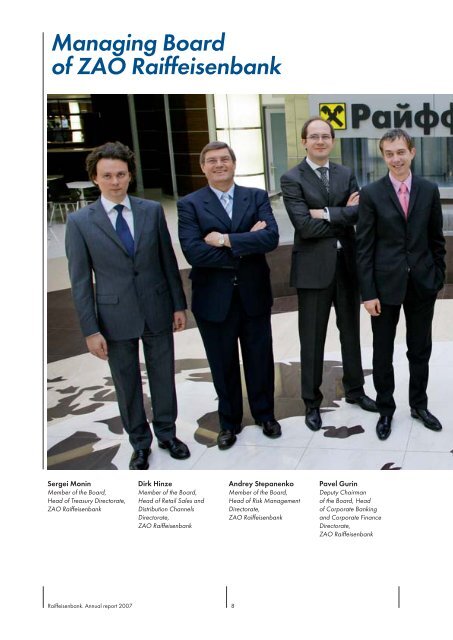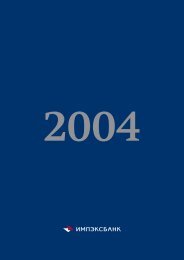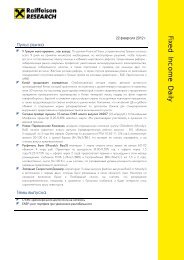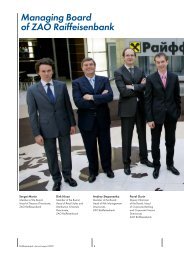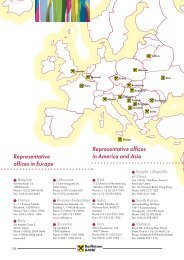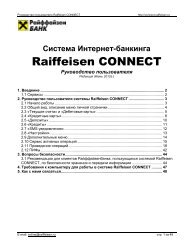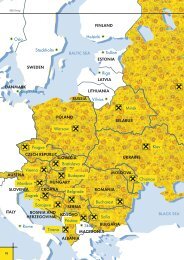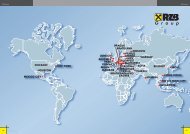Managing Board of ZAO Raiffeisenbank
Managing Board of ZAO Raiffeisenbank
Managing Board of ZAO Raiffeisenbank
Create successful ePaper yourself
Turn your PDF publications into a flip-book with our unique Google optimized e-Paper software.
<strong>Managing</strong> <strong>Board</strong><br />
<strong>of</strong> <strong>ZAO</strong> <strong>Raiffeisenbank</strong><br />
Sergei Monin<br />
Member <strong>of</strong> the <strong>Board</strong>,<br />
Head <strong>of</strong> Treasury Directorate,<br />
<strong>ZAO</strong> <strong>Raiffeisenbank</strong><br />
Dirk Hinze<br />
Member <strong>of</strong> the <strong>Board</strong>,<br />
Head <strong>of</strong> Retail Sales and<br />
Distribution Channels<br />
Directorate,<br />
<strong>ZAO</strong> <strong>Raiffeisenbank</strong><br />
Andrey Stepanenko<br />
Member <strong>of</strong> the <strong>Board</strong>,<br />
Head <strong>of</strong> Risk Management<br />
Directorate,<br />
<strong>ZAO</strong> <strong>Raiffeisenbank</strong><br />
Pavel Gurin<br />
Deputy Chairman<br />
<strong>of</strong> the <strong>Board</strong>, Head<br />
<strong>of</strong> Corporate Banking<br />
and Corporate Finance<br />
Directorate,<br />
<strong>ZAO</strong> <strong>Raiffeisenbank</strong><br />
<strong>Raiffeisenbank</strong>. Annual report 2007<br />
8
Johann Jonach<br />
Chairman <strong>of</strong> the <strong>Managing</strong><br />
<strong>Board</strong>, <strong>ZAO</strong> <strong>Raiffeisenbank</strong><br />
Christoph Schoefboeck<br />
Member <strong>of</strong> the <strong>Board</strong>, Head<br />
<strong>of</strong> Operations and<br />
IT Directorate,<br />
<strong>ZAO</strong> <strong>Raiffeisenbank</strong><br />
Roman Vorobiev<br />
Member <strong>of</strong> the <strong>Board</strong>,<br />
Head <strong>of</strong> Consumer Banking<br />
Directorate,<br />
<strong>ZAO</strong> <strong>Raiffeisenbank</strong><br />
Alexandre Ouchakov<br />
Member <strong>of</strong> the <strong>Board</strong>,<br />
Head <strong>of</strong> Economic<br />
Security, Assets Recovery<br />
and Compliance Control<br />
Directorate,<br />
<strong>ZAO</strong> <strong>Raiffeisenbank</strong><br />
<strong>Managing</strong> <strong>Board</strong> <strong>of</strong> <strong>ZAO</strong> <strong>Raiffeisenbank</strong><br />
9
Kaliningrad<br />
10:00<br />
11:00 12:00 13:00<br />
14:00<br />
In the rythm <strong>of</strong> the working day
15:00<br />
16:00 17:00 18:00 19:00<br />
20:00
Russia:<br />
Economic<br />
Prospects<br />
As the Russian economy continued its commodity-driven boom<br />
in 2007, the government gradually shifted its priority from stabilization<br />
to stimulating growth. A major development was growing<br />
investment in non-service sectors, which helped Russia evade<br />
the downturn that struck the global economy in the second half<br />
<strong>of</strong> the year. The flipside <strong>of</strong> the investment boom was high inflation,<br />
which has become one <strong>of</strong> the government’s biggest challenges.<br />
Economic growth<br />
Last year Russia showed resilience in the face <strong>of</strong> a challenging<br />
global environment to post stellar economic growth, estimated<br />
at 8.1%. Production increased 6.3%, mainly due to industrial<br />
growth, while capital expenditures grew by some 21% on significant<br />
investment in non-service sectors <strong>of</strong> the economy. In 2007,<br />
household incomes swelled more than 15%, which in turn bolstered<br />
retail growth. The two pillars <strong>of</strong> the Russian boom, investment<br />
and consumption growth, both appear resistant to growing<br />
international instability.<br />
Inflation<br />
Inflation, which climbed to 11.9% in 2007 from 9% in 2006,<br />
was a major disappointment. The inflation rate was fuelled by<br />
growing food and commodities prices as well as a record inflow<br />
<strong>of</strong> foreign capital in the first six months <strong>of</strong> the year and the easing<br />
<strong>of</strong> monetary policy in the second. The government was left<br />
with relatively few tools to fight the swelling prices as the fear <strong>of</strong><br />
damaging exports left the government little room to strengthen<br />
the ruble.<br />
Budget policy<br />
The 2007 budget enjoyed a surplus <strong>of</strong> RUR 2 trillion, or 6.1%<br />
<strong>of</strong> GDP, as the average oil price reached USD 69.3 per barrel,<br />
comfortably above the planned USD 61. Russia made advance<br />
foreign debt payments, although they fell well short <strong>of</strong> those made<br />
in 2005-2006. As a result, Russia ended the year as a net-creditor.<br />
The USD 156 billion Stabilization Fund was more than triple<br />
the country’s USD 37 billion foreign debt, according to 2007<br />
figures.<br />
Currency policy<br />
Despite growing inflationary pressure, high commodity prices<br />
and record capital inflows led to a strengthening <strong>of</strong> the ruble<br />
<strong>of</strong> about 1.4% against a dollar-euro currency basket. Ruble<br />
appreciation was then dampened because <strong>of</strong> fears <strong>of</strong> cutting<br />
growth, especially in the raw material sectors. Towards<br />
<strong>Raiffeisenbank</strong>. Annual report 2007<br />
12
the end <strong>of</strong> the year, the Central Bank insisted that the scope<br />
for strengthening the ruble to control inflation had been practically<br />
exhausted. Over the 12 months the ruble strengthened<br />
by 5.7% in real terms, significantly less than the 7.4% posted<br />
in 2006.<br />
Balance <strong>of</strong> payments<br />
Record growth in direct foreign investment dominated the balance<br />
<strong>of</strong> payments as the cumulative inflow <strong>of</strong> private capital<br />
reached around USD 82 billion, almost double the figure for<br />
2006. As a result, the gold holdings <strong>of</strong> the Central Bank increased<br />
by over USD 172 billion over the year to reach a record<br />
USD 476 billion.<br />
Money market<br />
As the credit crunch hit global markets hard towards the end<br />
<strong>of</strong> 2007, the Central Bank took a number <strong>of</strong> steps to maintain<br />
domestic liquidity. In particular, it extended the selection <strong>of</strong> refinancing<br />
tools <strong>of</strong>fered to banks, most importantly repo agreements.<br />
In the autumn, liquidity levels in the banking sector became<br />
unstable due to the shortage <strong>of</strong> external funding for the<br />
Russian banks. However, by the end <strong>of</strong> the year the situation<br />
had improved and the banking system demonstrated its ability<br />
to survive external shocks. However, a recurrence <strong>of</strong> episodes <strong>of</strong><br />
instability should not be ruled out considering the relatively high<br />
degree <strong>of</strong> integration between the Russian market and the global<br />
financial system.<br />
2008 forecast<br />
Relative to other emerging economies, Russia is less vulnerable to<br />
global economic problems, as its growth is primarily fuelled by<br />
internal demand. The principle source <strong>of</strong> growth in 2008 is likely<br />
to be increases in capital expenditure and investment in infrastructure.<br />
The state funds and development institutes that have already<br />
been established for this purpose should become a major source<br />
<strong>of</strong> financing.<br />
The clear dependence <strong>of</strong> growth rates on petroleum prices seen in<br />
the past two years has weakened due to a special tax regime levied<br />
on the extraction industries and the formation <strong>of</strong> Stabilization<br />
Fund to collect taxes on windfall commodity pr<strong>of</strong>its. Latent demand<br />
for bank services and the almost complete absence <strong>of</strong> exposure to<br />
the American mortgage crisis should both underline consumption<br />
growth and the gradual reduction <strong>of</strong> Russia’s dependence on the<br />
global markets.<br />
Russia: Economic Prospects<br />
13
Basic macroeconomic indices, results and forecasts<br />
Index preliminarily data 2002 2003 2004 2005 2006 2007<br />
2008<br />
forecast<br />
2009<br />
forecast<br />
GDP, EUR bln 364.4 383.3 476.3 614.7 777.0 940.0 1 074.4 1 268.0<br />
Annual GDP growth, % 4.7 7.3 7.2 6.4 7.4 8.1 6.5 6.0<br />
GDP per capita, EUR 2 508 2 651 3 312 4 294 5 453 6 613 7 609 9 044<br />
Industrial production growth, % 3.7 7.0 6.1 4.0 3.9 6.3 5.0 5.5<br />
Unemployment, % 8.0 8.6 8.2 7.6 7.2 6.1 6.1 5.9<br />
Manufacturing price inflation, % 10.5 16.5 23.4 20.7 12.4 12.0 25.6 15.3<br />
Consumer price inflation, % 15.1 12.0 11.7 10.9 9.0 11.9 12.1 9.8<br />
Budget surplus, % GDP 0.9 1.3 4.5 8.1 7.6 6.1 4.0 3.0<br />
Current account, % GDP 8.4 8.2 9.9 10.9 9.6 6.1 5.4 3.2<br />
Direct foreign investment, % GDP 0.0 –0.4 0.5 0.2 0.8 2.1 0.7 1.2<br />
Gold holdings, EUR bln 42.0 58.0 88.9 149.1 224.0 325.2 360.2 440.1<br />
External debt, % GDP 44.2 43.1 36.0 33.7 31.7 35.6 32.4 33.8<br />
RUR/USD exchange rate as at year end 31.9 29.2 27.7 28.7 26.3 24.6 24.6 25.4<br />
RUR/EUR exchange rate as at year end 33.5 36.9 37.7 33.9 34.7 35.9 35.7 35.6<br />
Source: Rosstat, Bank <strong>of</strong> Russia, Raiffeisen Group estimates<br />
<strong>Raiffeisenbank</strong>. Annual report 2007<br />
14
Foreign investment inflows<br />
USD, bln<br />
160<br />
Non-service sectors<br />
Annual growth, %<br />
24<br />
120<br />
80<br />
40<br />
0<br />
18<br />
12<br />
6<br />
–40<br />
1998 1999 2000 2001 2002 2003 2004 2005 2006 2007<br />
0<br />
2001 2002 2003 2004 2005 2006 2007<br />
Source: Rosstat, Bank <strong>of</strong> Russia,<br />
Raiffeisen Group estimates<br />
External corporate debt growth<br />
Net capital inflow<br />
Direct foreign investment<br />
Source: Rosstat, Bank <strong>of</strong> Russia,<br />
Raiffeisen Group estimates<br />
GDP<br />
Industrial production<br />
Basic capital investments<br />
Inflation<br />
Annual growth, %<br />
60<br />
50<br />
40<br />
30<br />
20<br />
10<br />
0<br />
january 02<br />
july 02<br />
january 03<br />
july 03<br />
january 04<br />
july 04<br />
january 05<br />
july 05<br />
january 06<br />
july 06<br />
january 07<br />
july 07<br />
january 08<br />
Source: Rosstat, Bank <strong>of</strong> Russia,<br />
Raiffeisen Group estimates<br />
M2 CPI PPI<br />
Russia: Economic Prospects<br />
15
Raiffeisen International<br />
and the RZB Group<br />
at a glance<br />
<strong>ZAO</strong> <strong>Raiffeisenbank</strong> is a subsidiary <strong>of</strong> Raiffeisen International<br />
Bank-Holding AG, which in turn is a fully consolidated subsidiary<br />
<strong>of</strong> Vienna-based Raiffeisen Zentralbank Österreich AG (RZB). RZB<br />
is the parent company <strong>of</strong> the RZB Group and the central institution<br />
<strong>of</strong> the Austrian Raiffeisen Banking Group, the country's largest<br />
banking group by total assets with the widest local distribution<br />
network.<br />
RZB and Raiffeisen International have time and again underpinned<br />
their reputation as early movers and pioneers in CEE,<br />
having founded the first subsidiary bank in Hungary already in<br />
1986, three years prior to the fall <strong>of</strong> the Iron Curtain. In more than<br />
20 years <strong>of</strong> market presence, ten banks were founded and another<br />
ten were acquired. The resulting network covers the region<br />
with universal banks in the following 17 markets, servicing nearly<br />
14 million customers.<br />
Albania<br />
Belarus<br />
Bosnia and Herzegovina<br />
Bulgaria<br />
Croatia<br />
Raiffeisen Bank Sh.a.<br />
Priorbank, OAO<br />
Raiffeisen Bank d.d. Bosnia i Herzegovina<br />
<strong>Raiffeisenbank</strong> (Bulgaria) EAD<br />
<strong>Raiffeisenbank</strong> Austria d.d.<br />
Czech Republic<br />
Hungary<br />
Kosovo<br />
Poland<br />
Romania<br />
Russia<br />
Serbia<br />
Slovakia<br />
Slovenia<br />
Ukraine<br />
<strong>Raiffeisenbank</strong> a.s. and eBanka, a.s.<br />
Raiffeisen Bank Zrt.<br />
Raiffeisen Bank Kosovo J.S.C.<br />
Raiffeisen Bank Polska S.A.<br />
Raiffeisen Bank S.A.<br />
<strong>ZAO</strong> <strong>Raiffeisenbank</strong><br />
Raiffeisen banka a.d.<br />
Tatra banka, a.s.<br />
Raiffeisen Banka d.d.<br />
VAT Raiffeisen Bank Aval<br />
Raiffeisen International acts as these banks' steering company,<br />
owning the majority <strong>of</strong> shares (in most cases 100 or almost<br />
100%). Furthermore, many finance leasing companies (including<br />
one in Kazakhstan and in Moldova) are part <strong>of</strong> the Raiffeisen<br />
International Group. RZB owns 68.5% <strong>of</strong> the common stock.<br />
The balance is free float, owned by institutional and retail investors.<br />
The company's shares are traded on the Vienna Stock Exchange.<br />
With its continually growing regional and local presence, as<br />
well as its increasing and innovative product spectrum, Raiffeisen<br />
International has significantly contributed to the development<br />
<strong>Raiffeisenbank</strong>. Annual report 2007<br />
16
<strong>of</strong> both the region's banking environment and its overall economic<br />
state.<br />
As <strong>of</strong> 31 December 2007, Raiffeisen International's consolidated<br />
pr<strong>of</strong>it (after tax and minorities) rose by 42% to EUR 841 million.<br />
Having grown by 30%, the balance-sheet total amounted to EUR<br />
72.7 billion. The return on equity before tax stood at 25.7%, and<br />
the cost/income ratio improved to 57.6%. 3 015 business outlets<br />
covered the CEE-region and over 58 000 employees attended to<br />
13.7 million customers.<br />
Founded in 1927, RZB provides the full range <strong>of</strong> commercial<br />
and investment banking services. It is Austria's third largest bank.<br />
As <strong>of</strong> 31 December 2007, the RZB Group's balance-sheet total<br />
amounted to EUR 137.4 billion, up 19% compared with<br />
December 2006. IFRS-compliant pr<strong>of</strong>it before tax increased by<br />
nearly 16% to EUR 1 485 million. The return on equity before tax<br />
reached 22.2%, and the cost/income ratio was 56.9%. At the<br />
reporting date, the Group employed a staff <strong>of</strong> more than 61 300<br />
worldwide.<br />
In addition to its banking operations – which are complemented<br />
by a representative <strong>of</strong>fice in Russia (Moscow) – RZB runs several<br />
specialist companies in CEE <strong>of</strong>fering solutions, among others, in<br />
the areas <strong>of</strong> M&A, real estate development, fund management<br />
and mortgage banking.<br />
In Western Europe and the USA, RZB operates a branch<br />
in London and representative <strong>of</strong>fices in Brussels, Frankfurt,<br />
Madrid, Milan, Paris, Stockholm, and New York. A finance<br />
company in New York (with representative <strong>of</strong>fices in Chicago,<br />
Houston and Los Angeles) and a subsidiary bank in Malta<br />
complement the scope. In Asia, RZB runs branches in Beijing<br />
(with a representative <strong>of</strong>fice in Zhuhai), Xiamen (China)<br />
and Singapore as well as representative <strong>of</strong>fices in Ho Chi Minh<br />
City, Hong Kong, Mumbai, Tehran and Seoul. This international<br />
presence clearly underlines the bank's emerging markets<br />
strategy.<br />
RZB is rated as follows:<br />
Standard & Poor's Short term A-1<br />
Long term A+<br />
Moody's Short term P-1<br />
Long term<br />
Aa2<br />
Financial Strength<br />
C<br />
Raiffeisen International and the RZB Group at a glance<br />
17
Anapa<br />
Belgorod<br />
Bryansk<br />
Cherepovets<br />
Essentuki<br />
Ivanovo<br />
Kaluga<br />
Kazan<br />
Kirov<br />
Krasnodar<br />
Lipetsk<br />
Moscow<br />
Nizhny Novgorod<br />
Orel<br />
Rostov-on-Don<br />
Saint Petersburg<br />
Saransk<br />
Saratov<br />
Smolensk<br />
Sochi<br />
Stary Oskol<br />
Stavropol<br />
Taganrog<br />
Tula<br />
Volgograd<br />
Voronezh<br />
Yaroslavl<br />
Zheleznogorsk<br />
11:00<br />
10:00 12:00<br />
14:00<br />
In the rythm <strong>of</strong> the working day
15:00<br />
16:00 17:00 18:00 19:00<br />
20:00
Vision<br />
and Mission<br />
Vision<br />
We are the leading universal bank across Russia for all customers<br />
caring for quality.<br />
Mission<br />
We seek long-term customer relationships.<br />
We provide a full range <strong>of</strong> high quality financial services<br />
throughout Russia.<br />
We co-operate closely with all members <strong>of</strong> RZB Group.<br />
We achieve sustainable and above-average return on<br />
equity.<br />
We empower our employees to be entrepreneurial and foster<br />
their development.<br />
<strong>Raiffeisenbank</strong>. Annual report 2007<br />
20
Human<br />
Resources<br />
Policy<br />
The completion <strong>of</strong> the merger <strong>of</strong> OAO IMPEXBANK and <strong>ZAO</strong><br />
<strong>Raiffeisenbank</strong> Austria provided a huge boost to our staff numbers,<br />
posing a range <strong>of</strong> new challenges for Human Resources in<br />
employee management, rotation, training and development.<br />
With the integration <strong>of</strong> Impexbank’s extensive regional network,<br />
the unified bank ended the year with roughly the same number <strong>of</strong><br />
staff in the regions as in Moscow.<br />
A new structure was introduced in HR department: HR Account<br />
Managers who are in close contact with business areas take<br />
care <strong>of</strong> individual differentiated needs <strong>of</strong> <strong>Raiffeisenbank</strong>’s departments.<br />
Due to the development <strong>of</strong> the Bank’s thriving retail network,<br />
a record number <strong>of</strong> new retail employees were hired. In order<br />
to meet its growing appetite for talent, <strong>Raiffeisenbank</strong> expanded<br />
its retail banking program for young pr<strong>of</strong>essionals. Following<br />
traineeships, 126 people were hired on a permanent basis, three<br />
times more than last year. A special trainee program was launched<br />
to form a pool <strong>of</strong> future employees in the areas <strong>of</strong> risk management,<br />
treasury and internal audit.<br />
Also in 2007 the Bank finalized its personnel development strategy<br />
for the next three years. Its key elements include performance<br />
management, talent management and the development <strong>of</strong> managers<br />
at all levels. As part <strong>of</strong> the Impexbank integration process,<br />
more than 300 managers participated in change management<br />
training programs; teambuilding events for employees from various<br />
departments supported the effective collaboration in the unified<br />
bank.<br />
With the target to establish a retail business employee training<br />
system, HR set up a Training Centre and hired, trained and certified<br />
in-house instructors for Moscow and the Regions. Over<br />
the year the centre’s team created 14 training programs and<br />
trained 3 980 employees. Training took place in the regions for<br />
the first time.<br />
Total staff number<br />
Employees: Moscow vs the Regions<br />
10 000<br />
7500<br />
9 217<br />
5000<br />
4000<br />
4454 4763<br />
5000<br />
2500<br />
0<br />
2 595<br />
616<br />
1 727<br />
397<br />
1 065<br />
2002 2003 2004 2005 2006 2007<br />
3000<br />
2000<br />
1000<br />
0<br />
1759<br />
857<br />
1129<br />
836<br />
537<br />
359<br />
498<br />
38 79<br />
208<br />
2002 2003 2004 2005 2006 2007<br />
Source: <strong>Raiffeisenbank</strong><br />
Source: <strong>Raiffeisenbank</strong><br />
Moscow<br />
Regions<br />
Human Resources Policy<br />
21
The most significant projects included the drafting <strong>of</strong> training materials<br />
and holding seminars on the newly designed catalogue <strong>of</strong><br />
services <strong>of</strong>fered by the unified bank. A compulsory training program<br />
title “Proud to give Better Service” was also provided to<br />
customer service employees. Designed to train staff in <strong>Raiffeisenbank</strong>’s<br />
unrivalled standards <strong>of</strong> service, the course was held in<br />
every branch and was attended by over 1 600 employees. More<br />
than 450 employees attended training programs and seminars<br />
conducted by external training organizations both in Russia and<br />
abroad.<br />
<strong>Raiffeisenbank</strong> continued to pay considerable attention to distance<br />
learning. In 2007, over 6 000 employees received distance<br />
training, more than 15 new courses and tests were developed,<br />
and a new unified distance learning platform was chosen<br />
for the unified bank. Over 1 000 <strong>ZAO</strong> <strong>Raiffeisenbank</strong> employees<br />
throughout Russia began learning English using a speciallydesigned<br />
course combining distance e-learning with traditional<br />
classes.<br />
In 2007, a Compensation and Benefits Team was set up by HR<br />
with the goal <strong>of</strong> calibrating compensation for <strong>Raiffeisenbank</strong>’s<br />
employees based on an internal system <strong>of</strong> job classification and<br />
regular comparison with employment market data. The compensation<br />
system was designed to boost results and efficiency and<br />
ensure external and internal balance and fairness <strong>of</strong> compensation<br />
while keeping abreast <strong>of</strong> changes on the employment market.<br />
Basic employee salary review rules were also developed<br />
and a bonus system was implemented for sales staff achieving<br />
sales and quality targets. The system is to be further refined in<br />
2008. After the Impexbank merger, <strong>Raiffeisenbank</strong> analyzed,<br />
revised and publicized the benefits available to employees, including<br />
voluntary health insurance, preferential employee loans,<br />
special banking product rates, corporate pension plan, as well<br />
as other benefits.<br />
The Bank succeeded in creating a united pr<strong>of</strong>essional team that<br />
achieved significant success in 2007, and we can look ahead<br />
with optimism.<br />
<strong>Raiffeisenbank</strong>. Annual report 2007<br />
22
Anti-Money<br />
Laundering Policy<br />
Recognizing good will as one <strong>of</strong> its most valuable assets, <strong>Raiffeisenbank</strong><br />
does everything it can to protect its own reputation and<br />
that <strong>of</strong> its clients by precluding exposure to money laundering or<br />
the financing <strong>of</strong> terrorism.<br />
The Bank’s main aims in this area are:<br />
Preventing the use <strong>of</strong> the Bank’s products and services as<br />
tools for criminals, including money laundering, fraud, the financing<br />
<strong>of</strong> terrorism and other corrupt practices.<br />
Protecting the good will <strong>of</strong> the Bank and its customers.<br />
Under the Russian law, and following internal procedures, the<br />
Bank has developed the following set <strong>of</strong> measures to control compliance<br />
risks:<br />
we have established a set <strong>of</strong> Internal Control Rules to prevent<br />
money laundering and the funding <strong>of</strong> terrorism;<br />
risk control systems are being unified across the Bank’s<br />
branches and subdivisions ;<br />
we ensure that all employees are fully committed to the prevention<br />
<strong>of</strong> money laundering and terrorist funding;<br />
our s<strong>of</strong>tware is continuously fine-tuned to ensure the timely<br />
identification <strong>of</strong> suspicious transactions and those subject to mandatory<br />
control;<br />
we provide regular compliance training for employees using<br />
state-<strong>of</strong>-the-art technologies.<br />
In addition to the above procedures we follow the "know your client”<br />
principle in strict adherence with the requirements <strong>of</strong> regulators,<br />
following Russian and Western confidentiality standards and<br />
the rules <strong>of</strong> non-disclosure <strong>of</strong> banking secrets.<br />
The notion “compliance risk” is understood in accordance with the requirements <strong>of</strong> Basel Committee, as a risk <strong>of</strong> legal or political sanctions, material financial losses, or damage<br />
to business reputation, which the Bank may incur as a result <strong>of</strong> a failure to comply with the relevant laws, guidelines, rules, standards and codes <strong>of</strong> conduct established<br />
by self-regulating organizations and applied to banking transactions.<br />
Anti-Money Laundering Policy<br />
23


